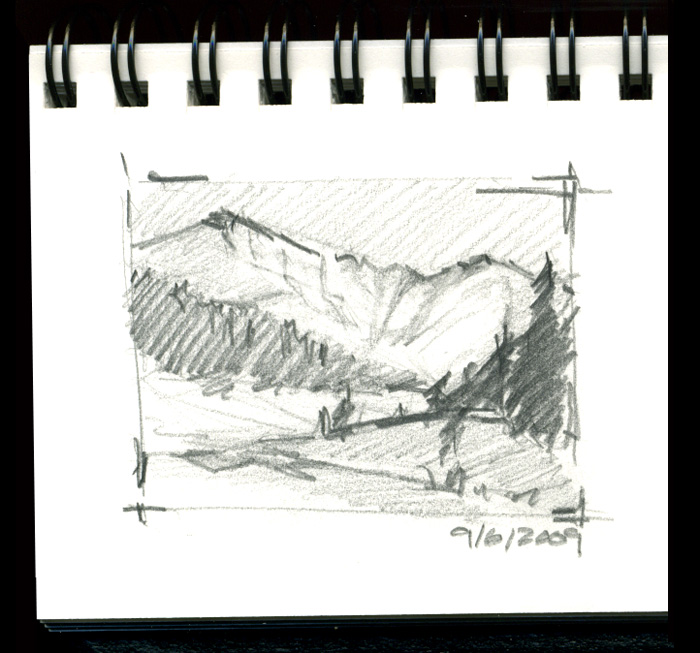Breathing Space
Position your subject so there is sufficient "breathing room" between the front of your subject and the rendering border. Otherwise, things can appear cramped or crowded-even off-balance. It's unnerving for the viewer to see a subject just about to leave the frame.
Motion Blur
Did you enjoy this blog post? If so, then why not:
Leave Comment | Subscribe To This Blog | Email Me
Keep An Open Mind
A major part of any staging process involved trail and error, shifting objects around while paying close attention to how the objects interact. Consider how colors overlap, how objects cast shadow on one another and how certain effects are more pleasing than others.
Here Are 7 Tips For Better Composition.
- Have a basic layout in mind, vertical or horizontal.
- Have reference photos
- Removing objects can be as helpful as adding new ones
- Experiment
- Cast shadows are a wonderful way to explain form. A shadow gives solidity to the object casting the shadow, and the shape of the shadow can help explain other forms as well.
- As you refine a composition, pay attention diagonal lines and angles created by objects; try to make diagonals more interesting through a slight adjustment. Also avoid creating tangents (places where objects abut or overlap one another) that are visually confusing.
- Be open to removing something if it isn't working, even towards the end of th process. Fine tuning the negative spacing, as well as the way the various shapes overlap.
Keep An Open Mind
Did you enjoy this blog post? If so, then why not:
Leave Comment | Subscribe To This Blog | Email Me
Thumbnail Sketches
Sketching is a good way to build your composition with simple shapes, lines, and tone. Nobody has to see your sketches, and they don't need to be refined; just start sketching. Start with simple shapes, and build upon that. Your sketches can fall into three groups.
Croquis
A Croquis is a thumbnail sketches that establish the image's main concept and sets the composition by indicating the most important shapes and values.
Esquisse
An Esquisse is a refined version of the Croquis: a more resolved thumbnail with a refined value structure and something closer to the final composition.
Étude
Is a drawing of an individual natural element, such as a tree, a patch of undergrowth, or a rock outcropping.
Thumbnail Sketches
Did you enjoy this blog post? If so, then why not:
Leave Comment | Subscribe To This Blog | Email Me
Creating a Strong Composition
The composition should be simple, and it should be about one thing, or concept. A deft artist can make even the most mundane subject interesting.
- When in doubt, keep it simple. Less is more.
- Take time to plan out your composition.
- interesting renderings have a harmonious balance of opposites, such as cool and warm, dark and light, thick and thin textures, detail and ambiguity, and hard and soft edges.
- The unequal treatment of these elements is pleasing to our senses.
Seek an interesting flow of eye movement - avoid a static composition.
Great compositions don’t just happen by accident. They take planning, patience, and a knowledge of all the visual elements at your disposal.
Did you enjoy this blog post? If so, then why not:
Leave Comment | Subscribe To This Blog | Email Me
Side Lighting in CG
Side lighting emphasizes an object's mass and helps develop the contours of its form; however, a light placed directly in front of the object (or multiple lights evenly spaced on either side) will seem to flatten the object by centering the highlight, restricting the shadow area, and limiting the range of value that defines the object. Not to be overlooked, of course, is the strength of the light source itself. Extreme drama often requires the greatest contrast possible.
Although lights and shadows exist in nature as the by-products of strict physical laws, CG artists often adjust them to enhance the three-dimensional effect of a rendering and/or provide greater compositional interest.
Side Lighting
Did you enjoy this blog post? If so, then why not:
Leave Comment | Subscribe To This Blog | Email Me
Unnecessary Complexity
As a rendering develops, you may realize that the solution to various compositional problems are resulting in unnecessary complexity. Your rendering might be deteriorating into fragmentation, and it commonly results from the artist's working on one segment of the composition at a time. While this may be a necessary part of the developmental phase of the rendering, such as isolated solutions may result in a lack of visual unity in the overall composition. However, by applying the principle of the economy, the rendering may regain a sense of unity.
Employing the principle of the economy means composing with efficient expressing an idea as a simply and directly as possible with no arbitrary or excessive use of the elements. Economy has no rules but rather must be an outgrowth of the artist's instincts. If something works with respect to the whole, it is kept; if disruptive, it may be reworked or rejected. A rendering is most successful when you express your ideas as simply and directly as possible.
Complexity
Did you enjoy this blog post? If so, then why not:
Leave Comment | Subscribe To This Blog | Email Me
Help Move The Eye Around The Rendering.
While developing a rendering, an artist strives for interest by creating differences that emphasize the degrees of importance of its various parts. These differences result from compositional considerations - some features are emphasized, and others are subordinated. This creates both primary focal points and secondary areas of interest that help move the eye around the rendering.
Areas become dominant when they are emphasized by contrasts that make them stand out from the rest. Contrast draws attention like the spotlight in a dramatic production or crescendo in a musical piece. In general, the greater the contrast, the greater the emphasis and the more dominant the area becomes.
Renderings that neglect varying degrees of dominance seem to imply that everything is of equal importance, resulting in a confusing rendering that gives the viewer no direction and fails to communicate.
Did you enjoy this blog post? If so, then why not:
Leave Comment | Subscribe To This Blog | Email Me
Balance
Gravity is universal, and we spend our daily lives resisting its influence. While walking, standing on one leg, or tipping back in a chair, we experience its effect and intuitively seek a state of balance.. When we are off balance, we have a strong fear that gravity will pull us over and we will fall down. Those expectations are so strongly ingrained in our subconscious that they also have an effect on the art we experience and produce. Most artwork is viewed in an upright orientation - in terms of top, sides, and bottom. as a result, gravity effects the visual composition.
Do you know why we frame our art? Artists often mat their work to gain an "aesthetic distance" or separation from the every day world. The hope is that we will see the work in a new context. But, even here, psychological factors can affect the visual weight and balance. In the case of a mat with two inch top, sides,and bottom, the bottom may have the illusion of being pinched or smaller than the other sides. This is an optical illusion that would make the artwork appear to be unstable, even rising on the wall. To compensate, the bottom measurement is generally made wider that that of the top and sides so that the whole rendering seems stabilized or balanced.
Balance
Did you enjoy this blog post? If so, then why not:
Leave Comment | Subscribe To This Blog | Email Me
A ground level view walks you right into the space
The most experiential and dynamic perspective is a ground level view. It offers the most telling opportunity to explain height and scale to our human dimensions, and through close proximity better explains choice of materials and perceived patterns/textures through color. The downside is that the further the point of interest is away the flatter and the less interesting the project. Plan element beyond 100' are harder to perceive by our standing 5'6" average eye height and must rely on more vertical element (people, vegetation and built forms) to perceive the use of that location.
To further the dynamic perspective, it is important to have a foreground,middle and background elements. This furthers the illusion of depth and can literally walk one into the rendering. What happens in the first 60 feet is the most dynamic area in the horizontal plane. If the horizontal plane is underdeveloped or unimportant, a worms eye view can increase the dynamic perspective and removes this area from the viewers perception.
In choosing a perspective, I create several perspective viewpoint based on requirements to best access the strength and weakness of each view and find that which I want to emphasis.
Did you enjoy this blog post? If so, then why not:
Leave Comment | Subscribe To This Blog | Email Me
How Low Can You Go?
Looking for a good way to raise the rendering bar? If possible, get down low, it's often just that simple. Rendering from a near-to-the-ground perspective is a surprisingly quick and effective method for making your rendering jump out from everyone else's
For example, most children are rendered from a typical grown-up height. For more emotionally engaging rendering, bring your camera to a kneeling height, to catch kids at their eye level.
All this goes for pets, too, as well as flowers and any other short subjects that can be captured low to the ground, For some subjects, you can combine a low perspective with getting close. This can further heighten the importance of small subjects by making them appear large in relation to their surroundings.
Outside on a sunny day include a bold blue sky as the background. For instance, get as low as you can go and then aim up at a subject such as a flower. This will let you include the sky as a colorful backdrop while treating your viewers to something new. I guarantee your viewers will appreciate your fresh take on things.
Did you enjoy this blog post? If so, then why not:
Leave Comment | Subscribe To This Blog | Email Me










